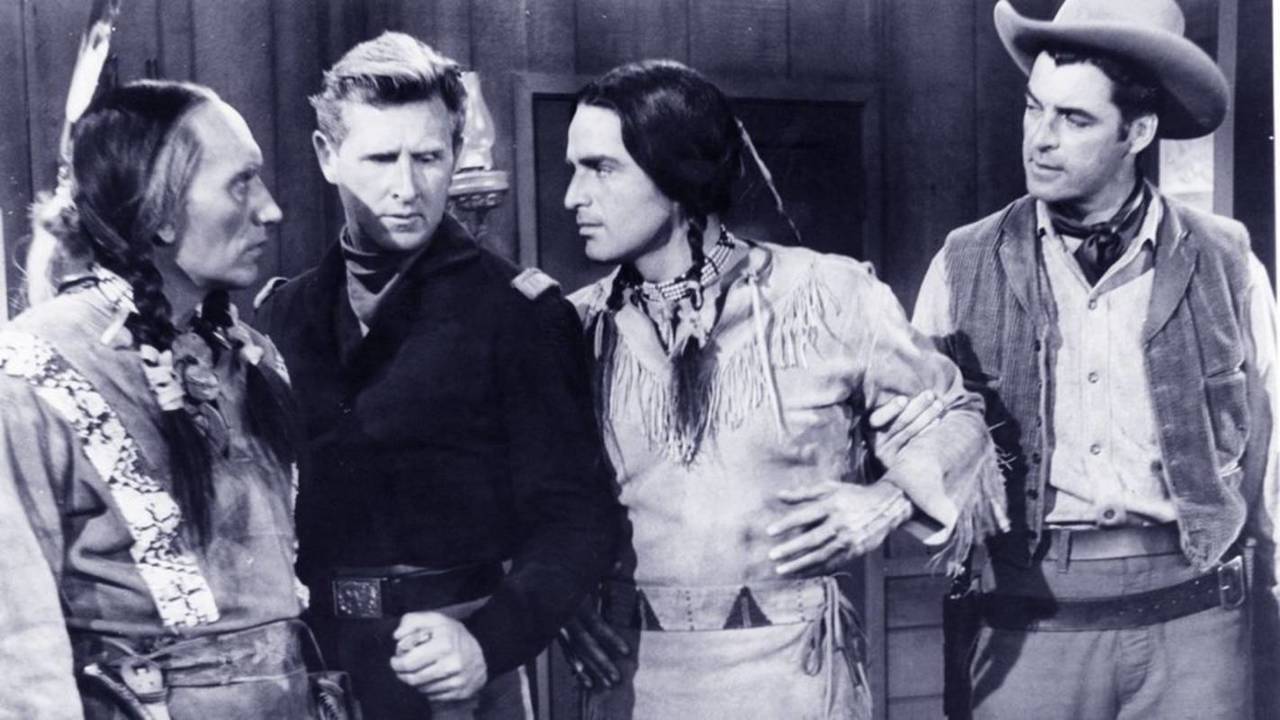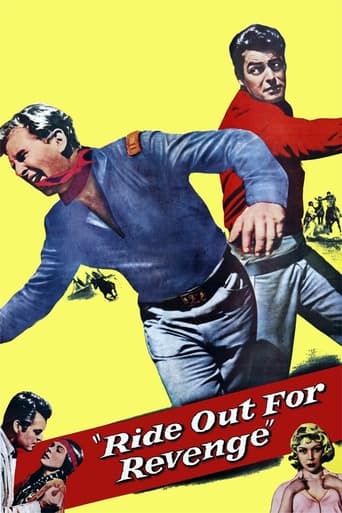

This is essentially the story of 3 men: Captain George(Lloyd Bridges), Chief Little Wolf(Vince Edwards), and Tate(Roy Calhoun). Captain George, a cavalry officer with seemingly only a handful of men to command, charged with keeping the peace in this frontier area, actually foments trouble by ordering the killing of Cheyenne Chief Yellow Wolf when he came to town asking for essential supplies to survive the coming winter. The chief didn't understand that Cpt. George had no authority to issue such supplies, since they were not on a reservation. Yellow Wolf had favored peaceful coexistence with the white settlers, whereas his son, Little Wolf, who succeeded him, talked of stealing the needed supplies from the army depot, and against going to the reservation in Oklahoma, which Cpt. George had received orders to facilitate. An additional reason for wanting the Cheyenne gone was that Yellow Wolf had brought a sample of gold-bearing rock from near the Cheyenne camp to show to Cpt. George, hoping to use it as a bargaining chip. Opposing the goals of both Cpt. George(and the army) and Little Wolf was ex-Indian fighter, Sheriff Tate. He wants peace and the status quo returned. But, the town's people interpret his stance as pro-Cheyenne. Many of them, including Tate. have lost loved ones to Indian murder, hence are not willing to tolerate Tate's position. Also, they know his girlfriend is the sister of Little Wolf, which they believe colors his stance. Thus, a town council recommends that they find a new sheriff. Even the death of his adopted son at the hands of the Cheyenne doesn't dissuade him from the relatively pro Cheyenne stance. At this point, Cpt. George wants both Tate and Little Wolf dead. Tate feels he must kill Little Wolf to prevent an attack on the town. Yet, when he has a chance to shoot him, he cannot. Pretty Willow(Joanne Gilbert)arranges for Tate to meet Little Wolf, out between the town and village. Somehow, Cpt. George receives this information, so plots to kill the two together, if they haven't already killed each other. Tate and Little Wolf knife fight each other, eventually falling into a lake. At this point, Cpt. George arrives, and shoots into the water, apparently killing Tate, while Little Wolf comes to shore. I will stop here, and let you find out the conclusion by seeing the film.Tate, if he lives, has the choice of 2 beautiful women, who are in love with him. One is European: Amy(Gloria Grahame), his landlady, who is very anti-Cheyenne, since they killed her husband and she sees them as greatly inferior culturally. The other is Pretty Willow, whom he favors. I think this union symbolizes a take-home message that interracial marriages should be considered OK, even if they often impose extra burdens and incompatibilities on the couple. However, personally, I think I would have chosen Amy, Tate's age mate, who easily expressed her emotions. In contrast, the much younger Pretty Willow seldom expressed her emotions by her face or words. Even the death of her father, brother, and apparently Tate didn't excite any crying, wailing, etc.. She just clamed up.I found several historical curiosities that relate to this film. The white town was given the fictional name of Sand Creek. Well, the infamous massacre of Cheyenne(mostly women and children) camped at Sand Creek, Colorado, created a stir among bipartisan whites, in it's day. Little Wolf was the name of a northern Cheyenne chief, who famously led a group of Cheyenne from the Oklahoma reservation to Montana, despite harassment by the army(see "Cheyenne Autumn") However, Yellow Wolf was the name of a Comanche, not Cheyenne, chief.See it at You Tube.
... View MoreSome westerns portrayed the American Indians as unthinking, one- dimensional idiots--riding around in circles waiting to be picked off by folks in the wagon train or by the cavalry. Others, like this one, are more sympathetic and show these same people as multidimensional and decent.When the film begins, the local chief is murdered. This is a serious problem, as the chief was a man of peace--and the new, younger chief is more headstrong and ready for revenge. Fortunately, there is a local guy (Rory Calhoun) who understands these Indians and treats them decently--and he can diffuse the situation. But the town is a hellish place that wants no part of peace and the local cavalry commander (Lloyd Bridges) is a cowardly jerk-face. With the Indians on the warpath and Calhoun's character the only person with any common sense, things look pretty awful for this stupid town.The Indians are generally portrayed well. However, a complaint I often have is that the main Indians are played by white folks--such as Vince Edwards! So, it's like two steps forward and one step back. Overall, however, the film is interesting and presents a more balanced view of the west. The only problem is that, at times, the characters are a bit more like caricatures--a bit too one- dimensional to be believable.
... View MoreSaddled with a ridiculously corny and over-talkative screenplay in which all the clichés of white men versus Indians are trotted out, plus the spectacle of Vince Edwards of all people playing the Indian chief's son, while the co-star of reasonably competent hero Rory Calhoun, namely Gloria Grahame, listlessly walks through a trite and entirely superfluous role, this is a movie to avoid. The director is a gent named Bernard Girard who worked mostly as a writer and director in TV. He just loves filling the screen with repetitive close-ups. In fact, the movie would be much more interesting if shorn of at least twenty minutes of this utterly boring material. On the other hand, most of the action footage is staged with reasonable competence and the use of some mildly attractive natural locations is at least a step in the right direction. Also on the plus side, Joanne Gilbert certainly lives up to her "Pretty Willow" name, while Frank DeKova manages to make his Indian chief reasonably credible. Lloyd Bridges, alas, has large slices of the script's verbosity to contend against, but at least he puts up a good fight.
... View MoreRide Out For Revenge is a sincere portrayal of the anguish of the American Indians, the Cheyennes specifically, in the aftermath of losing the Indian Wars. It also shows the bitter prejudice of the white settlers who have also suffered losses as a result of the wars.The problem I find with this film is the rather unbelievably noble portrayal of Rory Calhoun in the lead. Not his fault, there's not much he can do with a character that's just too good. As is explained he's sustained personal losses himself, a sister and husband killed and he's raising his nephew Michael Winkelman and boarding with widow Gloria Grahame. As fetching as she ever was in movies, Grahame's got a real thing for Calhoun and he may have given her a tumble once or twice, but right now Rory has got eyes for Indian maid Joanne Gilbert.I'm also not sure why a troop of cavalry is stationed in the town where Calhoun is marshal. But they're there and headed by Lloyd Bridges a captain who never would have found his way into any John Ford cavalry film. He's as slimy as they come. When chief Frank DeKova comes into town to plead for supplies for his people, he gets shot down in the street like a dog and son Vincent Edwards vows vengeance. That sets in motion all the events of the film that follows.With characters I just could not buy, Ride Out For Revenge falls short of its goal for sympathy for the Cheyenne. One of the main characters dies and one is thought to have died in the end. The actual death of the first should have set off a big inquiry.Kirk Douglas's Bryna Productions produced this one and Kirk was wise not to take the lead himself here.
... View More